Digital Poster
Imaging Psychiatric Disorders in Children & Adolescents
ISMRM & ISMRT Annual Meeting & Exhibition • 03-08 June 2023 • Toronto, ON, Canada

| Computer # | |||
|---|---|---|---|
5043. |
101 |
Elevated glutamine levels and activation of astrocytes involved
in excessive excitatory neurotransmissions in autism spectrum
disorder
Kiwamu Matsuoka1,2,
Masaki Oya1,3,
Manabu Kubota1,4,5,
Junya Fujino3,5,
Shisei Tei4,5,6,7,
Keisuke Takahata1,8,
Kenji Tagai1,
Yasuharu Yamamoto1,8,
Hitoshi Shimada1,9,
Chie Seki1,
Takashi Itahashi 5,
Yuta Y. Aoki5,
Haruhisa Ohta5,10,
Ryu-ichiro Hashimoto5,11,
Genichi Sugihara3,
Takayuki Obata12,
Ming-Rong Zhang13,
Tetsuya Suhara1,
Motoaki Nakamura5,14,
Nobumasa Kato5,
Yuhei Takado1,
Hidehiko Takahashi3,15,
and Makoto Higuchi1
1Department of Functional Brain Imaging, Institute for Quantum Medical Science, National Institutes for Quantum Science and Technology, Chiba, Japan, 2Department of Psychiatry, Nara Medical University, Kashihara, Japan, 3Department of Psychiatry and Behavioral Sciences, Graduate School of Medical and Dental Sciences, Tokyo Medical and Dental University, Tokyo, Japan, 4Department of Psychiatry, Graduate School of Medicine, Kyoto University, Kyoto, Japan, 5Medical Institute of Developmental Disabilities Research, Showa University, Tokyo, Japan, 6Institute of Applied Brain Sciences, Waseda University, Tokorozawa, Japan, 7School of Human and Social Sciences, Tokyo International University, Kawagoe, Japan, 8Department of Neuropsychiatry, Keio University School of Medicine, Tokyo, Japan, 9Center for integrated human brain science, Brain Research Institute, Niigata University, Niigata, Japan, 10Department of Psychiatry, School of Medicine, Showa University, Tokyo, Japan, 11Department of Language Sciences, Graduate School of Humanities, Tokyo Metropolitan University, Tokyo, Japan, 12Department of Molecular Imaging and Theranostics, Institute for Quantum Medical Science, National Institutes for Quantum Science and Technology, Chiba, Japan, 13Department of Advanced Nuclear Medicine Sciences, Institute for Quantum Medical Science, National Institutes for Quantum Science and Technology, Chiba, Japan, 14Kanagawa Psychiatric Center, Yokohama, Japan, 15Center for Brain Integration Research, Tokyo Medical and Dental University, Tokyo, Japan Keywords: Psychiatric Disorders, Psychiatric Disorders We conducted MRS and PET to examine if enhanced excitatory tones occur and correlate with astroglial activations and/or diminished dopaminergic suppression of astrocytic functions in autism spectrum disorder (ASD) cases. MRS revealed elevated glutamate and glutamine levels associated with astroglial activation in ASD versus control anterior cingulate cortex, while there were also inverse correlations between glutamine levels and dopamine D1 receptor availability in this area of both ASD cases and controls. Hence, dopamine transmissions may repress astroglial glutamine synthesis independently of the ASD etiology, while astroglial activation in ASD could elicit augmented glutamate synthesis and consequent excitation of neuronal tones. |
|
5044. |
102 |
Diffusion kurtosis and elastography of uncinate fasciculus
relate to dysfunctional emotion regulation and anxiety in youth
Melanie A Matyi1,
Leah D Church1,
Jeremy S Rudoler1,
Nadia Bounoua1,
Kaleigh E Wieand1,
Grace McIlvain2,
Curtis L Johnson2,
and Jeffrey M Spielberg1
1Psychological and Brain Sciences, University of Delaware, Newark, DE, United States, 2Biomedical Engineering, University of Delaware, Newark, DE, United States Keywords: Psychiatric Disorders, Adolescents, anxiety Mechanistic theories seeking to explain the onset of anxiety in adolescence propose that delayed myelination of the uncinate fasciculus (UF) confers risk for anxiety onset through, in part, deficits in regulation of emotions. Thus, we examined the relationship between two independent assays of UF structural integrity and measures of both dysfunctional emotion regulation and anxiety. We found that less UF structural integrity is related to more dysfunctional emotion regulation and anxiety. Furthermore, we found that dysfunctional emotion regulation mediates the relationship between UF structural integrity and anxiety. |
|
5045. |
103 |
Mapping altered cortical microstructural maturation with
diffusion kurtosis imaging in children with autism
Minhui Ouyang1,2,
Kay Sindabizera1,
Tianjia Zhu1,3,
Jeffrey Berman1,2,
J. Christopher Edgar1,2,
and Hao Huang1,2
1Department of Radiology, Children's Hospital of Philadelphia, Phildaelphia, PA, United States, 2Department of Radiology, Perelman School of Medicine, University of Pennsylvania, Philadelphia, PA, United States, 3Department of Bioengineering, University of Pennsylvania, Philadelphia, PA, United States Keywords: Psychiatric Disorders, Gray Matter, Diffusion/Other Diffusion Imaging Techniques The cellular and molecular processes inside the cerebral cortex play a critical role in typical brain development and neuropsychiatric disorders. Altered cytoarchitecture across brain regions in autism spectrum disorder (ASD) was found with histology. Here, we noninvasively mapped the whole-brain cortical cytoarchitectural maturation in 52 children aged 6-9 years with ASD and 59 age-matched typically developmental (TD) children with diffusion kurtosis imaging (DKI). Significant cortical mean kurtosis increases in the temporal and frontal regions were found in TD children with almost flat mean kurtosis changes in ASD observed, suggesting altered underlying cortical cytoarchitectural maturation in ASD. |
|
5046.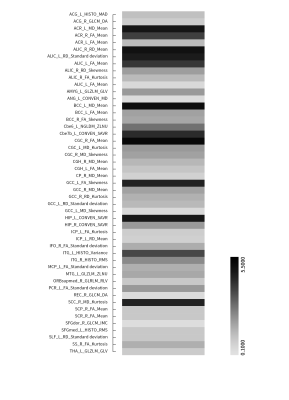 |
104 |
Prediction of early response to antidepressant medication in MDD
adolescents using radiomics analysis based on brain multiscale
structural MRI
Huan Ma1,
Jianzhong Yang2,
Yingying Ding1,
Kun Li1,
Dafu Zhang1,
Zhongping Zhang3,
and Xiaoyong Zhang4
1Department of Radiology, The Third Affiliated Hospital of Kunming Medical University, Kunming, Yunnan Province, China, 2Department of Psychiatry, The Second Affiliated Hospital of Kunming Medical University, Kunming, Yunnan Province, China, 3Philips Healthcare,Guangzhou China, Guangzhou, China, 4Clinical Science, Philips Healthcare, Chengdu, China, Chengdu, China Keywords: Psychiatric Disorders, Psychiatric Disorders, Major depressive disorder; Antidepressant medication; Magnetic resonance imaging; Radiomics; Machine learning Based on the radiomics analysis framework and using machine learning, this study constructed a multiscale structural MRI prediction model to predict the early response of MDD patients to antidepressant medication, and determined the radiomics features with high weight for SSRIs/SNRIs selection. The results showed that the baseline radiomics model after normalization can effectively predict the early treatment response of ADM in adolescent MDD patients, and is superior to the model based on conventional imaging indicators and unnormalized radiomics features. The AUC, accuracy, sensitivity and specificity of predicting SSRIs improvement and SNRIs improvement are 0.954, 89.2%, 87.4% and 88.5%, 0.942, 91.9%, 82.5% and 86.8%, respectively. |
|
5047. |
105 |
7T MRI in Tourette syndrome and correlations with clinical
ratings
Dimitrios G. Gkotsoulias1,
Anna Bujanow1,
Simon Schmitt2,
Henryk Barthel3,
Kirsten Mueller-Vahl2,
and Harald E. Moeller4
1NMR Group, Max Planck Institute for Human Cognitive and Brain Sciences, Leipzig, Germany, 2Clinic of Psychiatry, Social Psychiatry and Psychotherapy, Hannover Medical School, Hannover, Germany, 3Department of Nuclear Medicine, University of Leipzig, Leipzig, Germany, 4Max Planck Institute for Human Cognitive and Brain Sciences, Leipzig, Germany Keywords: Psychiatric Disorders, Quantitative Susceptibility mapping, QSM, 7T, Tourette Syndrome, Substantia Nigra, Basal Ganglia In this study, we used 7T MRI for identifying potential local associations of Quantitative Susceptibility Mapping (QSM) with tic severity in patients with Gilles de la Tourette syndrome (GTS), as well as T1w volumes for VBM analysis of the cerebellum. Our results indicate direct correlations of tic severity with the QSM values in substantia nigra and other basal ganglia regions, supporting the hypothesis that iron imbalance play a significant role in neurotransmitter dysregulations that lead to the symptomatology of GTS. VBM results show previously unreported GM morphometry alterations in Crus-I, a cerebellar region implicated in visual-motor integration, attention and cognition. |
|
5048. |
106 |
Functional Connectivity and Clinical Characteristics in Gilles
de la Tourette Syndrome
Renzo Torrecuso1,
Karsten Mueller1,
Kirsten Müller-Vahl2,
and Harald Möller1
1NMR, Max Planck Institute for Human Cognitive and Brain Sciences, Leipzig, Germany, 2Hannover Medical School, Hannover, Germany Keywords: Psychiatric Disorders, fMRI (resting state), Functional Connectivity, Tourette Syndrome Gilles de la Tourette syndrome (GTS) is characterized by the expression of tics and frequently co-occurs with comorbidities including obsessive compulsive disorder (OCD), depression, and attention deficit/hyperactivity disorder (ADHD). For a better discrimination of GTS’ manifestation in brain networks, we analyzed resting-state fMRI data from patients with “GTS only” (no comorbidities) and “GTS plus” (with comorbidities) based on clinical ratings. Our findings suggest that increased intrinsic connectivity of insular cortex with putamen are causally related to GTS while decreased connectivity of the frontal pole, medial temporal and superior frontal gyrus is likely to be related to comorbidities. |
|
5049. |
107 |
GABA Alterations Associated with Social Cognition Deficits in
Youth with Autism Spectrum Disorder Compared to Early-Onset
Psychosis
Rhideeta Jalal1,
Aarti Nair1,
Joseph O'Neill2,
Hector Gutierrez1,
Kristen Laulette3,
Mary Rshtouni3,
Katherine Karlsgodt3,
Carrie E. Bearden2,
and Brenda Bartnik-Olson4
1Psychology, Loma Linda University, Loma Linda, CA, United States, 2Psychiatry, University of California, Los Angeles, Los Angeles, CA, United States, 3Psychology, University of California, Los Angeles, Los Angeles, CA, United States, 4Radiology, Loma Linda University, Loma Linda, CA, United States Keywords: Psychiatric Disorders, Spectroscopy, Adolecents Proton magnetic resonance spectroscopy (1H-MRS) can provide valuable information about cortical activity and metabolite concentrations. Previous research using MRS has found alterations in the concentrations of neurotransmitters in neuropsychiatric disorders, notably in autism spectrum disorder (ASD) and early-onset psychosis (EOP). We used 1H-MRS to quantify signals associated with neurotransmitters in the dorsal anterior cingulate cortex (dACC), a brain region underlying social cognition, by measuring metabolite concentrations and its relationship to social impairments, in youth with ASD or EOP, and typically developing (TD) youth. |
|
5050.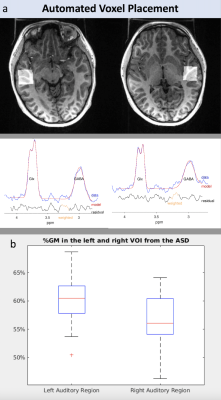 |
108 |
Evaluation of neurotransmitter profiles in the Auditory Cortex
in Children with Autism Spectrum Disorder
Maria Baida1,
Sana Vaziri1,
Marisa Lafontaine1,
Carly Demopoulos1,2,
Yi Li1,
and Yan Li1
1Department of Radiology and Biomedical Imaging, University of California San Francisco, San Francisco, CA, United States, 2Department of Psychiatry and Behavioral Sciences, University of California San Francisco, San Francisco, CA, United States Keywords: Psychiatric Disorders, Neuro, Spectroscopy In this study, we used an automated spectral prescription method that predefined the left and right auditory cortex to compare neurotransmitter concentrations between ASD and typically developing control (TDC) and evaluate their relationship to age, sex, and verbal abilities. We found metabolic differences in GABA+ concentrations between the left and right auditory cortex in TDC and ASD. However, no significance was found between TDC and ASD or between ASD with intact speech and impaired speech. |
|
5051. |
109 |
Diffusion Brain Imaging in Autistic Adolescents with and without
Speech Impairment
Yan Li1,
Marisa Lafontaine1,
Duan Xu1,
Yi Li1,
and Carly Demopoulos1
1University of California San Francisco, San Francisco, CA, United States Keywords: Psychiatric Disorders, Pediatric, autism, diffusion In this study, we performed diffusion weighted imaging in subjects with Autism Spectrum Disorder and typically growing controls (TDC) to compare the differences in apparent diffusion coefficient (ADC) values between the two groups and examine their relationship to speech impairment. |
|
5052. |
110 |
Image normalization can improve the effectiveness of radiomics
model based on multiscale structural MRI for diagnosing MDD and
StD in adolescents
Huan Ma1,
Yingying Ding1,
Jianzhong Yang2,
Kun Li1,
Dafu Zhang1,
Xiaoyong Zhang3,
and Zhongping Zhang4
1Department of Radiology, The Third Affiliated Hospital of Kunming Medical University, Kunming, Yunnan Province, China, 2Department of Psychiatry, The Second Affiliated Hospital of Kunming Medical University, Kunming, Yunnan Province, China, 3Clinical Science, Philips Healthcare, Chengdu, China, Chengdu, China, 4Philips Healthcare,Guangzhou China, Guangzhou, China Keywords: Psychiatric Disorders, Adolescents, Major depressive disorder, Subthreshold depression, Magnetic resonance imaging, Radiomics, Machine learning We developed a radiomics classifier for MDD and StD in adolescents with multiscale structural MRI after normalization, and it had the best performance and was superior to the classifier based on conventional image indicators and unnormalized radiomics features. The AUC, sensitivity, and accuracy for discriminating MDD and HC, MDD and StD, StD and HC were 0.928, 89.2% and 90.5%, 0.821, 73.0% and 80.8%, 0.836%, 82.4% and 79.7% respectively. The high discriminant radiomics features of cuneiform lobe and cerebellum (lobule ⅵ, ⅶ-b and ⅹ, 4/5 area of cerebellar vermis) played a key role in the pathophysiological mechanism of MDD and StD. |
|
5053. |
111 |
A study of AFQ-based method in adolescents with first-episode
treatment-naive major depressive disorder
Lingyu Jian1,2,
Junfeng Li3,
Kefeng Li4,
Xiaoyong Zhang5,
and Min Luo6
1Changzhi Medcal College, Changzhi, China, 2Zigong Fourth People‘s Hospital, Zigong, China, 3Heping Hospital Affiliated to Changzhi Medical College, Changzhi, China, 4Centre for Artificial Intelligence Driven Drug Discovery, Faculty of Applied Sciences, Macao Polytechnic University, Macao, China, 5Clinical Science,Philips Healthcare, Chengdu, China, 6Zigong Fourth People‘s Hospital, ZIgong, China Keywords: Psychiatric Disorders, Diffusion Tensor Imaging The study is to explore the changes of white matter fiber tracts in adolescents with first-episode treatment-naive depression using a DTI-based AFQ method. Adolescent depression can cause damage to multiple white matter fiber tracts. The severity of depression is positively correlated with white matter fiber damage. The depression prediction model established has a certain accuracy in the diagnosis of adolescent depression. White matter fiber tract abnormalities may be the pathophysiological mechanism of depression and can be used as a potential biomarker for the diagnosis of depression. |
|
5054.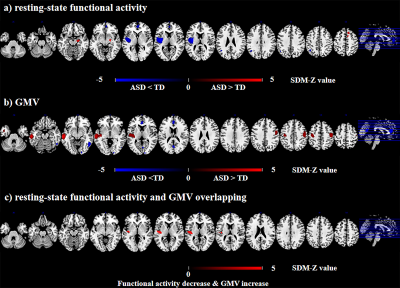 |
112 |
Functional and structural brain alterations in autism spectrum
disorder: A multimodal meta-analysis of neuroimaging studies
Zixuan Guo1,
Hong Yan1,
Xinyue Tang1,
long Qian2,
and Ying Wang1
1Medical Imaging Center, First Affiliated Hospital of Jinan University, Guangzhou, China, 2MR Research, GE Healthcare, Beijing, China Keywords: Psychiatric Disorders, Brain, fMRI(resting state); Grey matter volume Numerous neuroimaging studies conducted have shown functional and structural brain alterations in patients with ASD. We conducted a whole-brain voxel-wise meta-analysis to summarize previous inconsistent results by using Seed-based d Mapping software. In the present multimodal meta-analysis, functional and structural alterations in specific regions were found, which provide new insights into the quest for a neuroimaging-based marker for ASD. |
|
5055. |
113 |
Alteration in white matter tracts in early onset schizophrenia
Using Diffusion tensor imaging
Mukesh Kumar1,
S Senthil Kumaran1,
Pankaj Pankaj1,
and Rajesh Sagar2
1Dept. of NMR & MRI Facility, All India Institute of Medical Sciences, New Delhi, India, 2Department of psychiatry, All India Institute of Medical Sciences, New Delhi, India Keywords: Psychiatric Disorders, Diffusion Tensor Imaging, Early-onset Schizophrenia The study investigated white matter tracts disruption in early-onset Schizophrenia (EOS). Our finding revealed decreased white matter tracts fractional anisotropy (FA) and increased radial, axial and mean diffusivity in EOS as compared to controls, suggesting thinner packing of axon and fiber bundle. Disrupted white matter fibers may be associated with impaired neurobehavior in EOS. |
|
5056. |
114 |
Repeated Electroconvulsive Shock does not Affect Cognition and
Neurometabolism in Mouse Brain
Ajay Sarawagi1,2 and
Anant Bahadur Patel1,2
1Department of NMR Microimaging and Spectroscopy, CSIR - Center for Cellular and Molecular Biology, Hyderabd, India, 2Academy of Scientific & Innovative Research (AcSIR), Ghaziabad, India Keywords: Psychiatric Disorders, Spectroscopy, Metabolism, Glutamate, GABA, 13C NMR Electroconvulsive therapy is an effective treatment for chemo-resistant depression. The impact of electroconvulsive shock (ECS) on cognition and neurometabolism is not clear. The memory of mice was evaluated using Y-maze test. The rates of glucose oxidation (CMRGlc(ox)) were measured by 1H-[13C]-NMR spectroscopy together with an infusion of [1,6-13C2]glucose after 24 hours and 3 months of the repeated ECS. The spontaneous alternation was decreased after 24 h and 1 month of repeated ECS, and was restored after two months. The CMRGlc(ox) was reduced in PFC after 24 h of ECS. These changes were normalized after 3 months of ECS. |
|
5057.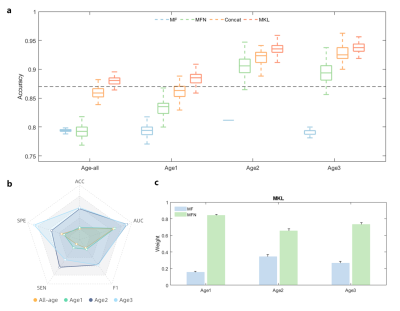 |
115 |
Diagnosis of Autism Spectrum Disorder Using Age-Specific Brain
Morphological Features
Dongyue Zhou1,
Yunge Zhang1,
Siting Xiong1,
Wei Zhao1,
Fengyu Cong1,
and Huanjie Li1
1Dalian University of Technology, Dalian,Liaoning, China Keywords: Gray Matter, Multimodal, Autism Spectrum Disorder (ASD); multiple kernel learning (MKL); structural magnetic resonance imaging (sMRI); multi-feature-based network (MFN) Autism Spectrum Disorder (ASD) diagnosis based on sMRI can be more objective than clinical scales due to high heterogeneity. However, accuracies on large heterogeneous datasets were not high. We used age-specific features based on ABIDE II dataset to distinguish ASD and control. In the meanwhile, we combined two kinds of age-specific structural features including regional and interregional features using multiple kernel learning (MKL) to complement each other. Results showed that our procedure achieved accuracy of more than 85 percent on discriminating ASD from control. |
|
5058.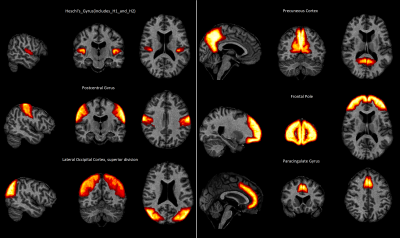 |
116 |
Myelination differences between cerebrum and cerebellum at
early-stage schizophrenia detected by macromolecular proton
fraction MRI.
Ekaterina Krupina1,
Andrei Valerievich Manzhurtsev2,3,4,
Maxim Vadimovich Ublinskiy2,3,
Olga Vasilievna Bozhko3,
Galina Mamedova5,
Vadim Ushakov1,5,6,
Natalia Zakharova5,
Vasiliy Leonidovich Yarnykh7,8,
Denis Andreyuk5,
Maxim Borisovich Shlyapnikov5,
Georgiy Kostiuk5,
and Tolib Abdullaevich Akhadov3
1National Research Nuclear University MEPhI, Moscow, Russian Federation, 2Emanuel Institute of Biochemical Physics of the Russian Academy of Sciences, Moscow, Russian Federation, 3Clinical and Research Institute of Emergency Pediatric Surgery and Trauma, Moscow, Russian Federation, 4Moscow State University, Moscow, Russian Federation, 5Psychiatric Clinical Hospital 1 named N.A. Alekseev., Moscow, Russian Federation, 6Institute for Advanced Brain Studies, Moscow State University, Moscow, Russian Federation, 7Radiology, University of Washington, Seattle, WA, United States, 8Laboratory of Neurobiology, Research Institute of Biology and Biophysics, Tomsk State University, Tomsk, Russian Federation Keywords: Psychiatric Disorders, Nervous system, myelin, schizophrenia The purpose of this study is to identify quantitative alterations of the myelin content using the macromolecular proton fraction (MPF) method. Forty-five subjects, 22 controls and 23 schizophrenia patients participated in the study. A significant decrease in myelination in schizophrenia was observed in the left and right cerebral cortex and in the left and right cerebral white matter. No myelination alterations in the entire cerebellum (not separated into regions) were detected. The differences found in the regional and global myelination at an early stage of schizophrenia may provide additional information for understanding the biological mechanisms of the disease. |
|
5059. |
117 |
Obsessive-compulsive symptom-related brain connectivity
associated with calcium homeostasis in first-episode drug-naïve
schizophrenia
Qi Zhang1,
Hui Sun1,
Jiaxin Zeng1,
Xia Wei1,
Huaiqiang Sun1,
Naici Liu1,
Chengmin Yang1,
Wenjing Zhang1,
Jing Dai2,
Qiyong Gong1,
and Su Lui1
1Huaxi MR Research Center (HMRRC), West China Hospital of Sichuan University, Chengdu, China, 2The Clinical Hospital of Chengdu Brain Science Institute, University of Electronic Science and Technology of China, Chengdu, China Keywords: Psychiatric Disorders, Psychiatric Disorders, schizophrenia The present study recruited a Chinese Han cohort of first-episode patients with never-treated schizophrenia. Partial least squares regression was used to investigate the functional connectivity specifically related to obsessive-compulsive symptom and the results mainly involved the frontal lobe, insula, temporal lobe, and Rolandic operculum. Using association rules, we dug that Calcium level exhibited a bidirectional effect with the strength of the connection between the right Rolandic operculum and the right insula, especially regarding PCDHGB1 expression in the right Rolandic operculum. |
|
5060. |
118 |
In vivo primary sensorimotor cortex glutathione does not differ
in autistic children
Yulu Song1,2,
Kathleen E. Hupfeld1,2,
Christopher W. Davies-Jenkins1,2,
Helge Zöllner1,2,
Deana Crocetti3,
Steve C.N. Hui1,2,
Vivek Yedavalli1,
Georg Oeltzschner1,2,
Natalie Alessi3,
Mitchell A. Batschelett3,
Nicolaas A.J. Puts4,5,
Stewart H. Mostofsky3,6,7,
and Richard A.E. Edden1,2
1The Russel H. Morgan Department of Radiology and Radiological Science, Johns Hopkins University School of Medicine, Baltimore, MD, United States, 2F.M. Kirby Research Center for Functional Brain Imaging, Kennedy Krieger Institute, Baltimore, MD, United States, 3Center for Neurodevelopmental and Imaging Research, Kennedy Krieger Institute, Baltimore, MD, United States, 4Department of Forensic and Neurodevelopmental Sciences, Sackler Institute for Translational Neurodevelopment, Institute of Psychiatry, Psychology, and Neuroscience, King's College London, London, United Kingdom, 5MRC Centre for Neurodevelopmental Disorders, King’s College London, London, United Kingdom, 6Department of Neurology, The Johns Hopkins University School of Medicine, Baltimore, MD, United States, 7Department of Psychiatry and Behavioral Sciences, The Johns Hopkins University School of Medicine, Baltimore, Baltimore, MD, United States Keywords: Psychiatric Disorders, Spectroscopy, Autism Redox imbalance has been suggested as a pathophysiological factor in autism spectrum disorder (ASD). Edited MRS can be used to measure levels of glutathione, the most abundant redox compound in the brain. This study aims to compare glutathione levels in autistic children and typically developing children (TDC). Edited data were collected from the primary sensorimotor cortex (SM1) in 34 children with ASD and 31 TDC and quantified using Osprey. No difference was found in GSH levels in the SM1 between these two groups. |
|
5061. |
119 |
Long-term effects of childhood trauma subtypes on adult brain
function
Qin Liu1,
Weiyin Vivian Liu2,
Jianjian Cai1,
and Tian Tian1
1Department of Radiology, Tongji Hosptial, Tongji Medical College, Huazhong University of Science and Technology, Wuhan, China, 2MR Research, GE Healthcare, Beijing, China Keywords: Psychiatric Disorders, Trauma, childhood trauma. Childhood trauma is prevalent in our society, but little is known about why and how different forms of early traumatic experiences exert long-term effects on differential brain function in adulthood. This study aimed to measure experience-specific neural correlates of distinct subtypes of childhood trauma. Our data showed the differential associations of abusive and neglectful experiences with brain function in adulthood. These experience-specific associations could underpin potentially differential risks of specific forms of psychiatric sequelae in adulthood. More attention to maltreated children and timely psychological treatment are needed to reduce the incidence of psychosis. |
|
5062. |
120 |
Relationships among brain controllability, cognition, and
clinical symptoms of major depressive disorder
Qian Li1,
Youjin Zhao1,
Yaxuan Wang1,
Fenghua Long1,
Qiyong Gong1,
and Fei Li1
1Department of Radiology, Huaxi MR Research Center (HMRRC), West China Hospital of Sichuan University, Chengdu, China Keywords: Psychiatric Disorders, Brain, major depressive disorder Major depressive disorder (MDD) showed both clinical symptoms and cognitive deficits. Prior studies have typically examined either symptoms or cognition correlated with brain measures, thus causing a paucity of stable brain markers that capture the full characteristics of MDD. Sparse canonical correlation analysis was used to assess the associations between two multi-dimensional clinical measurements (symptoms and cognition) and brain controllability of MDD. Average controllability of dorsal attention network (DAN) and visual network reached high associations with clinical variates in MDD, and altered controllability of DAN in patients could induce impairment of cognitive flexibility, and thus cause severe depressed mood. |
|
The International Society for Magnetic Resonance in Medicine is accredited by the Accreditation Council for Continuing Medical Education to provide continuing medical education for physicians.